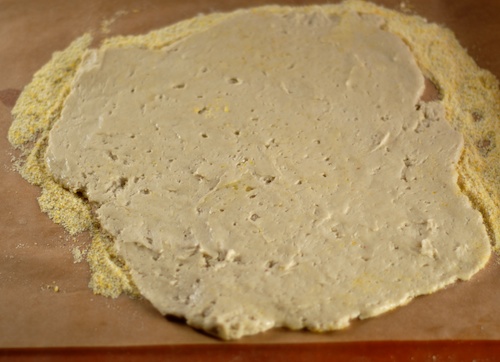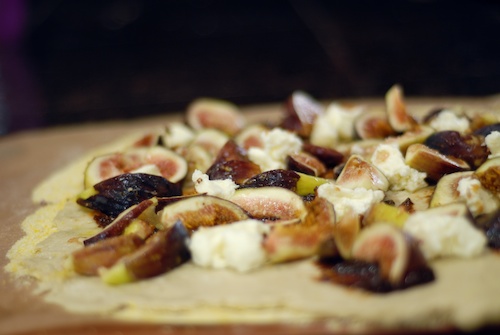This dough makes a crust that’s a little less puffy and crispy than a regular pizza crust, yet close enough that my family doesn’t much notice or mind if I make a gluten-free crust. The main difference is in the preparation. The dough is much more delicate and harder to handle than a regular gluten crust. Follow my tips in the recipe and I think you’ll be able to get it in the oven without frustration.
Here’s the crust rolled out:

gluten free pizza crust on a piece of cornmeal-covered parchment paper
Note that since the dough is delicate, I moved it onto the pizza stone without attempting to slide it off the parchment paper I rolled it out on. This pizza had a ‘teen’ side with feta cheese and an ‘adult’ side without:

gluten-free pizza atop parchment paper on the pizza stone
Here it is seen from the ‘adult’ side, ready to eat. This particular topping had olive-oil-and-herb-marinated ‘olives of love,’ artichoke hearts, chopped red onion, and on the ‘teen’ side, feta cheese.

Gluten-free pizza seen from the non-dairy ‘adult’ side. With olives, red onions, artichoke hearts.
I made this with Pamela’s Gluten-free Bread Mix. Pamela’s calls for cooking a crust made with their mix for 20 minutes at a lower temperature, but I prefer to cook it at for 10 minutes at the same high heat I usually use for pizza to get it as crisp as possible. As always, you’ll get a crispier pizza using a pizza stone.
This recipe makes two pizza crusts. I often make one dinner pizza and one dessert pizza. I’ll share a couple of my dessert pizza recipes next!
- 1½ cups lukewarm water (between 105 and 115 F)
- 2¼ tsp. active dry yeast
- 3½ cups Pamela's Gluten-Free Bread Mix & Flour Blend
- ¼ cup extra virgin olive oil, plus a little extra to brush on the rolled-out pizza
- coarse corn meal for sprinkling on parchment paper
- Using a stand mixer with the whisk attachment, mix water, yeast, gluten-free bread mix, and olive oil on medium speed for two minutes.
- The pizza dough will be delicate and sticky. Grease your hands with olive oil before handling it.
- Divide dough into two halves, form into balls, let rest in greased, covered bowls for one hour. Don't worry about the lack of rise, the dough will puff up later in the oven.
- Place pizza stone into cold oven and heat oven to 500 degrees F.
- Spread parchment paper over a pizza peel or large cutting board.
- Sprinkle the parchment paper generously with corn meal.
- Using greased hands, transfer one half of the dough to the cornmeal-covered parchment paper.
- Roll out with a greased rolling pin. Roll gently to avoid the dough sticking and tearing. It if tears, stick the torn piece back together, it will still work just fine.
- Prepare second pizza in the same manner.
- Brush pizza gently with a little olive oil and top as desired.
- Cook pizzas one at a time using the pizza stone.
- To avoid any problems with the pizza tearing, I do not try to slide it off the peel onto the stone. I grab the parchment paper on both sides of the pizza and lift it to transfer it from the peel to the stone. lIt helps to have another person holding the peel next to the open oven while you do this.
- Cook for 10-11 minutes or until edges of the pizza begin to brown.







{ 2 comments… read them below or add one }
We made mac n’ cheese for a friend recently who is gluten-free. It was the first time I’d ever had gluten free noodles. It was weird. I could definitely tell the difference in flavor and texture. I wonder if I’d have the same experience with pizza dough?
Probably. The strands of gluten that form when you knead strengthen the dough and give it texture and chewiness. They hold in bubbles of yeast, helping the dough rise better. In fact some bakers add a bit of gluten flour to their recipe to help it rise better. So it is challenging to make a gluten-free risen bread product. Noodles are easier because they don’t have to rise. But still, the texture will not be quite the same.